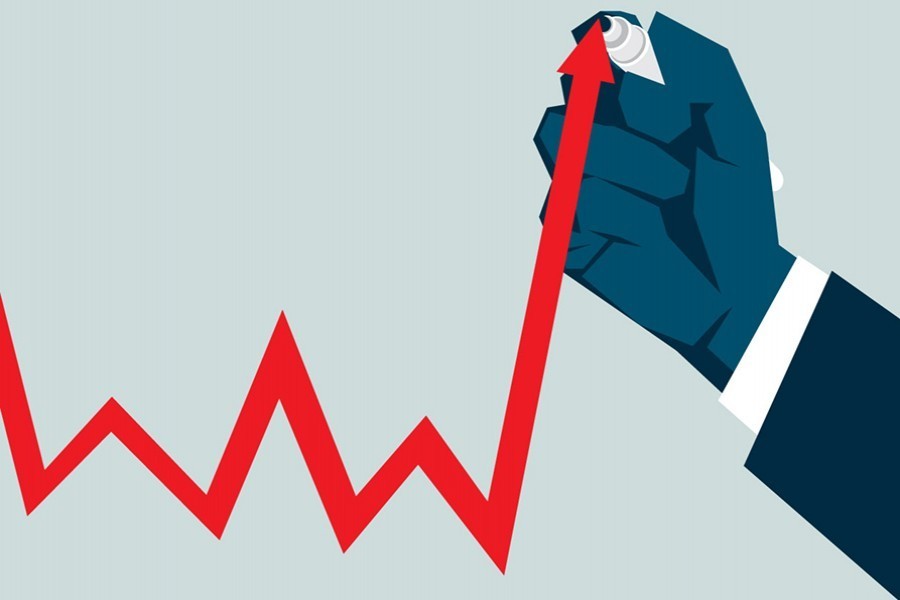Bangladesh economy is set to return to the 7-plus growth regime in the current fiscal year (FY22), thanks to strong recovery of the economic activities after the pandemic. After recording 7.88 per cent growth in Gross Domestic Product (GDP) in FY19, it fell to 3.45 per cent in FY20 due to Covid-19. Economic activities, however, regained some strong pace in the later year which is reflected in 6.94 per cent growth rate, although provisional estimate. Now, the finance minister AHM Mustafa Kamal is quite optimistic that the current fiscal year will see a higher growth of 7.20 per cent. On several occasions during the last few months, he has clearly asserted this. He also mentioned that per capita income will reach US$2,785 in the current fiscal year.
A number of factors are there behind the finance minister's assertion on higher GDP growth. Big jump in trade, robust collection of tax revenue and double digit growth in the private credit inflow provide the policymakers necessary comfort regarding the economic boom. The finance minister also pointed out that no area of the economy has negative growth.
What is more critical is the finance boss's argument that expansionary monetary policy has played a vital role for the economy to bounce back and achieve higher growth in the last fiscal year. He was of the view that when many countries in the world did not dare to take this path, Bangladesh followed the expansionary path (UNB, February 10, 2022). It means, expansion of credit under a number of stimulus packages as well as reduced interest rates, the central bank channelled sufficient amount of liquidity in the market.
To support the various economic activities during the pandemic, the government in collaboration with the Bangladesh Bank announced a series of stimulus packages and refinance schemes equivalent to Tk 1.28 trillion which is around 4.60 per cent of GDP. The total amount of money was disbursed gradually over a year since April 2020.
It appears that the stimulus packages contributed to increasing money supply in the market. As the economy started to come back to normalcy, regular economic activities have gained further momentum creating demand for more credit. The outcome is a further increase in money supply in the market which is also reflected in the central bank statistics. It showed that broad money or M2 increased by 12.60 per cent in FY20 over FY19 and further jumped by 13.60 per cent in FY21. Though the annual monetary policy statement set a target of 15.60 per cent growth in money supply for FY21, the real growth was recorded at a lower level indicating that economy was not in a position to absorb the higher credit.
What is interesting is that the country's inflation is significantly linked to the money supply. For instance, the growth of money supply dropped to 9.25 per cent in FY18 from 10.90 per cent in FY17. Annual average rate of inflation, however, increased to 5.78 per cent in FY18 from 5.44 per cent in FY17. Again, inflation rate declined further to 5.47 per cent in FY19 when money supply increased to 9.90 per cent.
The apparent link between the money supply and inflation needs to be examined rigorously to determine the actual relationship. However, annual average inflation increased modestly to 5.65 per cent in FY20 but declined slightly to 5.56 per cent in FY21 when money supply recorded higher growth of 12.60 per cent and 13.60 per cent respectively. It indicates that the rise in money supply did not push the inflation significantly which is not a usual phenomenon.
Economic theory and empirical evidences make it clear that money supply is a key factor regarding the movement of the inflation. It is difficult to comprehend why inflation rate would be almost static when there was a big jump in the growth of money supply. Moreover, if money supply contributes to higher GDP growth by enhancing the consumption spending, an inflationary pressure will be there.
The economic growth in the last fiscal year was largely driven by the consumption spree as total consumption spending increased by 14 per cent. The boom in consumption is substantially matched with the higher money supply. Though the official statistics of CPI-based inflation does not reflect it, price spiral for the last couple of months indicates that demand-pull factor is also working beside the cost-push factor.
The demand generated by a group of higher income people and their spending spree contributed to overall consumption disproportionately. It is mainly due to growing income disparity in the country where a small number of people have appropriated the major portion of the national resources. The Eight Five-Year Plan (8FYP) succinctly recognised the problem saying: "Rising inequality (measured by various inequality indices - Gini; and Palma ratio) tend to suggest that 'economic growth' may not be fully inclusive." During the pandemic, the non-inclusiveness of growth became widely visible although policymakers are yet to recognise the reality.
Income inequality leads to spending disparity and so consumption disparity. A small portion of the population is spending and consuming whatever they want irrespective of price and supply. They are pushing the aggregate demand to a certain extent. This is creating demand-pull inflation while majority of the population is struggling hard to keep pace with price hike. As official inflation figure is still low, policymakers find it comfortable no matter whatever the real price situation is. They are probably satisfied that the country is now on 'high growth, low inflation' trajectory, at least by the official numbers. Unfortunately, the numbers do neither entirely tally with each other, nor with the real world. High growth of GDP is pushing up the price inflation to a large extent, no matter what the official statistics say.


